1 September 1778
Piranesi told Francesco to etch a select set of dimensions onto the Circus of Caracalla plan within the site plan tomorrow (Wednesday), and then on Thursday, after Laura's done with the Circus Maximus, he can etch the index numbers onto that circus plan. Seeing the Circus of Caracalla site plan again reminded Piranesi of Sir Roger Newdigate, so throughout the rest of the day he told whoever was listening most of his Roger Newdigate stories.
1 September 1977
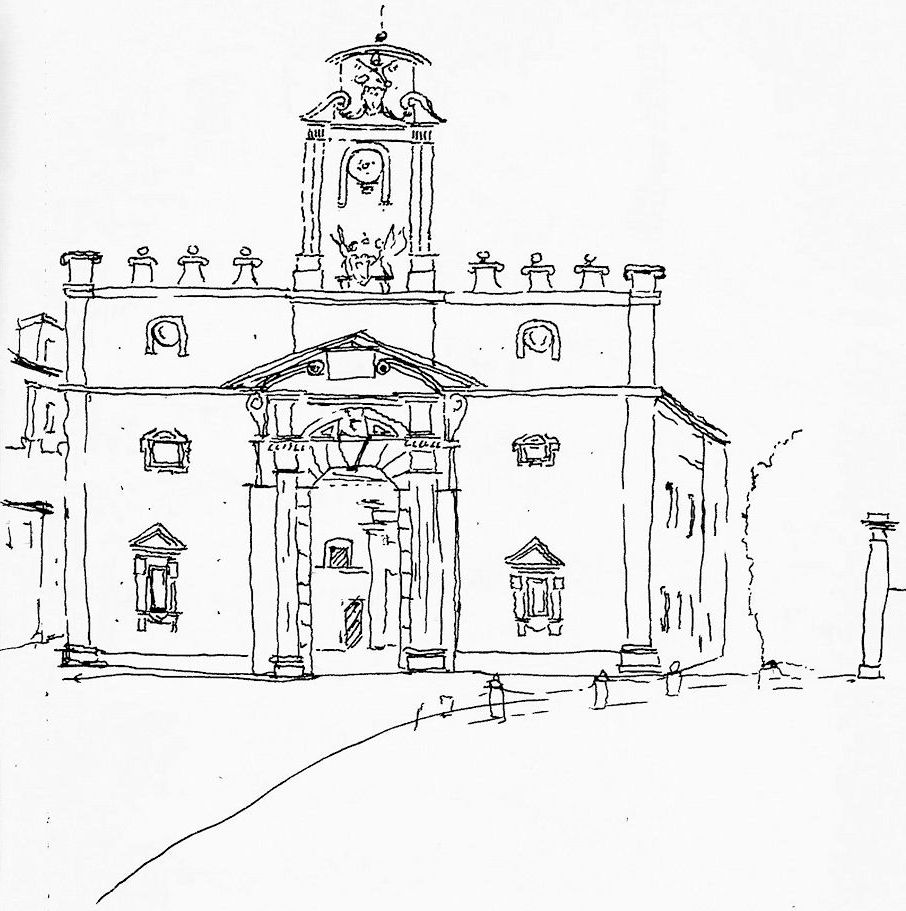
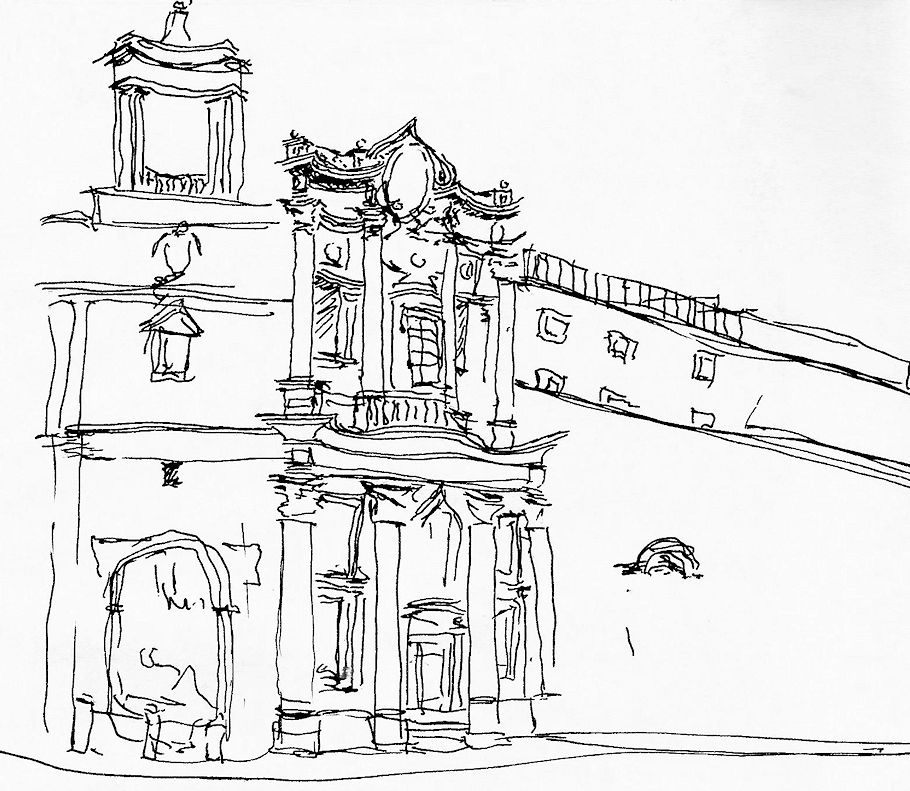
Since this was (supposed to be) my last morning in Rome, and our flight back to the States was rescheduled for later in the early evening, I decided to do a morning walking tour on my own. I took the bus to the Porta Pia, and from there I walked down Via Venti Settembre to San Carlo alle Quattro Fontane, where I went inside and lit a candle for a safe flight back home. From San Carlo alle Quattro Fontane I walked up Via delle Quattro Fontane and Via Sistina to the top of the Spanish Steps. Went down the Spanish Steps and took Via Babuino to Piazza del Popolo. Stopped half way between the Spanish Steps and Piazza del Pololo to look, one last time, at the sidewalk outside the nonexistent Pensione For You, where I spent my first hours in Rome three weeks earlier. Crossed through Piazza del Popolo, then through the Popolo gate, up Via Flaminia a few blocks, turned left onto Via P.S. Mancini and down a couple blocks to the Villa Hélèna.
By late afternoon we were all on our way back to Ciampino airport, but almost as soon as we got there we were told that our flight had already left at its original departure time. Near panic, lots of confusion, and some of the other students had barely any money left. (Not sure when it happened, but we did learn that we missed our flight because when the pensione manager at Villa Hélèna called the airport the day before to confirm our flight home schedule, instead of calling Ciampino Airport he called Leonardo Da Vinci Airport where a flight from Rome to New York City was departing that early evening.) Anyway, we, all the students of the group, were provided lodgings in a youth hostel for the night.
1 September 2003
The last line (so far) of 'It rocked Eisenman on his chair...' reads:
"It wasn't enough that Maria remained a virgin consort to a 14 year-old Emperor, she then had to witness the only English Pope take her sarcophagus for himself. She's now writing The Plays of Nicholas Breakspear."
1 September 1159 - death of Pope Adrian IV [aka Nicholas Breakspear]
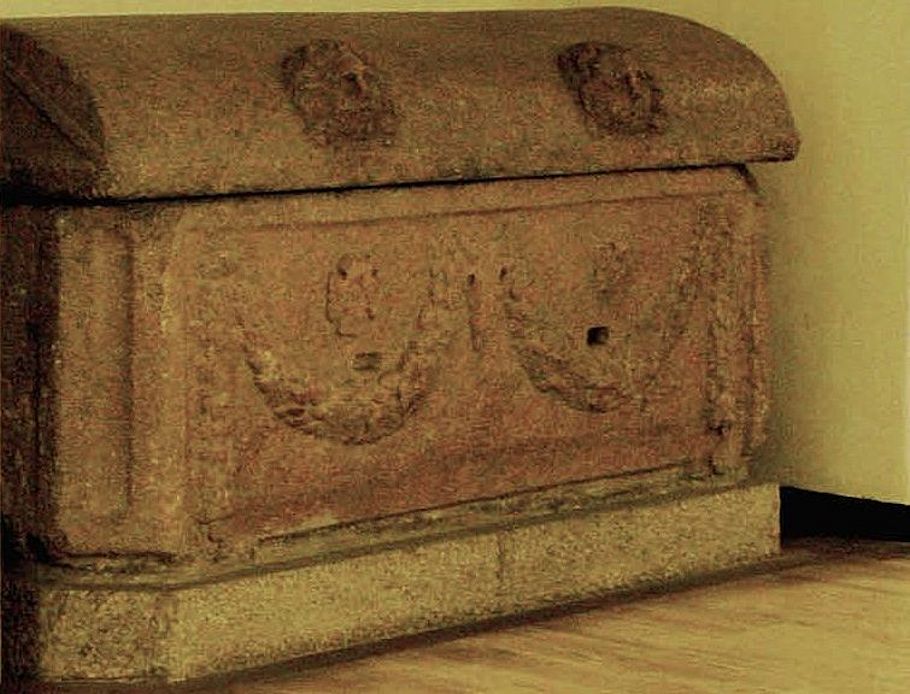
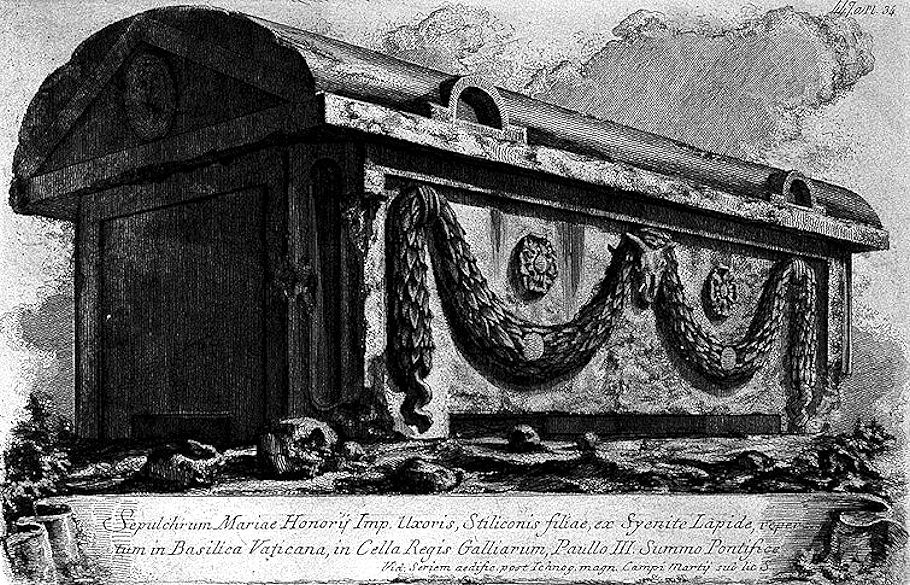
The tomb of Pope Adrian IV is presently within the Vatican crypt of the Basilica of St. Peter, and it bears a stricking resemblence to the Sarcophagus of Maria, first wife of the Emperor Honorius as depicted by Piranesi within Il Campo Marzio... ...except Piranesi does not depict the two Medusa head medalions. Obviously Piranesi took some artistic license in his depiction (which in itself is not unusual for him), but this difference raises a whole casket full of problems. For a start, it's most unlikely for the sarcophagus of a teenage Christian imperial wife to bear such pagan iconography--Maria was married to the son of the Emperor Theodusius I who legally abolished all paganism throughout the Roman Empire and installed Christianity as the only state religion. Was Piranesi trying to hide some sort of Imperial blemish? I doubt it. Looking deeper, if Breakspear was entombed within this late-antique sacophagus soon after his death 854 years ago today, then it could not be the sarcophagus of Maria because that sarcophagus was not discovered until 3 February 1544 during the demolitions of the old Basilica of St. Peter, Vatican. Of course, the papal remains could have been placed within the newly found sarcophagus after 1544, but there are no records of such an event having taken place. In fact, there are no records, as far as I can find, that even link the sarcophagus of Pope Adrian IV with the sarcophagus of Maria, except, as it happens, my own recognition of the resemblence between the actual papal sarcophagus and Piranesi's depiction of the imperial sacophagus. So what's really going on here?
There's no question that Piranesi understood the histoirical/archaeological significance of the sarcophagus of Maria:
2007.11.09 "If you actually study the [Ichnographia of the] Campo Marzio you'll find the starting point, framework and the millennium's worth of buildings that Piranesi utilized. First there are the altar and race course dedicated to Mars by Romulus in the mid-eighth century BC. Incidentally, this is how the Campo Marzio received its name--the fields of Mars. And to manifest the framework there is the last Imperial artifact of the Campo Marzio, the sepulcher of Empress Maria, wife of Honorius, from the early 5th century AD. Indeed the sarcophagus of Empress Maria holds a key position within the Il Campo Marzio publication."
This key position is as head-piece of the Latin language dedication of Il Campo Marzio to Scotsman Robert Adam.
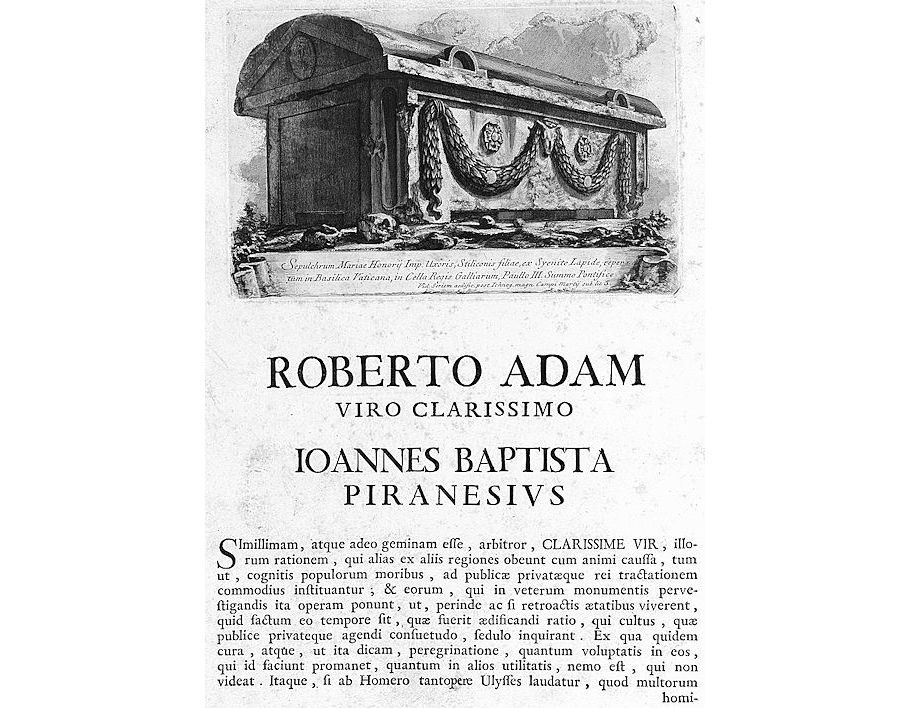
2002.01.19: "The sarcophagus of Maria may well be the last substantial imperial artifact of (the city of) Rome, and, after an illustrious title page and a frontispiece, it is an image of the sarcophagus of Maria that Piranesi uses to begin his Campo Marzio publication. In a most elegantly covert way, Piranesi began the 'history' of the Campo Marzio with what is really it's ending, and what is probably the world's greatest designed architectural inversionary double theater goes on from there."
What may well actually have happened is that, after finding textual evidence of the discovered existence of the sarcophagus of Maria, Piranesi went about looking for the actual sarcophagus, but didn't find it anywhere within the collections of the Vatican or Rome. However, he still needed an image of the sarcophagus to grace the Dedication to Robert Adam, so he decided to use the late-antique sarcophagus that happens to hold the remains of the only English Pope as a model. I wonder if Adam was even ever aware of the fabricated connection.
1 September 2022
Excerpts from Sir Roger Newdigate's diary for 1774 and 1775 mentioning Piranesi:
1774
26th December 'In Coach to Sr Piranesa looked over all his Prints'
30th December 'to Piranesi'
1775
3rd January 'Sre Piranese came & staid furnishing the Bucina'
4th January 'In C[oach]. to 2 Bookbinders ab. the [. . .] Piranese'
10th January 'Piranese's view & c' [i.e. Newdigate's evening study]
13th January 'Piranese's works'
14th January 'Piranese's works'
25th January 'S.re Cavai. Piranese for a set of his Prints & c'
Between 27th February and 5th March 'Sre Piranese for a set of his Works bound in Calf for a present'
6th March 'Home S.re Piranese Came'
8th March 'Sre Piranese bt his plan of the Circus of Caracalla & explaind it'
10th March 'To Sre Piranesi who lent his plan of Circus of Caracalla went there, saw the Temple & Portico and examined the Circus till past 4'
13th March [visits] 'Piranese & c'
18th March 'at home looking over my 2d set of Piranesi's works'
19th March 'at home Piranese's works'
20th March 'to Sre Piranese'
21st March [discoursing with] 'Abbé Grant and Sre Piranese upon Arch of Constantine'
6th May 'To Mr Jenkins 'Agreed with Sre Piranese for a Candelabra for 1000 Scudi to be pd on delivery this day 6 months'
7th May 'S.re Piranese pd in part for his two Candelabra'
1st July 'Piranese' [among persons seen]
2nd July 'av Piranese came [morning call]
From Francis Russell, "Piranesi and Sir Riger Newdigate: a footnote" in The Burlington Magazine (CL, August 2008), p. 547.
"By 1807, Pietro and Francesco had decided to divide their interests. Pietro returned to Rome and started a shop on the via Babuino, just off Piazza di Spagna."
Heather Hyde Minor, Piranesi's Lost Words (University Park: The Pennsylvania State University Press, 2015), p. 196.

|